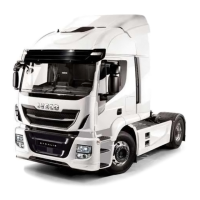NEW STRALIS MY2016 ‒ GUIDELINES FOR BODYBUILDERS
CHASSIS INTERVENTIONS
2.6 INSTALLING THE TOW HOOK
21
– Printed 692.68.697 – 5 Ed. - Base 03/2019
Towing hooks for conventional trailers
According to Directive 94/20/CE, both for the choice of the hook and for the application of any reinforcements to the rear cross-
bar, it is important to take into account the action of the horizontal forces generated by the masses of the tractor and trailer, based
on the following formula:
D = 9.81 (T • R) / (T + R)
D = representative value of tow hook class [kN]
T = maximum mass of the tractor [t]
R = maximum mass of trailer with mobile vertical drawbar [t]
Tow hooks for centre axle trailers
Centre axle trailers are defined as those that have the drawbar rigidly connected to the frame and the axle (or more close axles)
placed at half the length of the same chassis.
Compared to the articulated drawbars, the rigid drawbar acts on the tow hook with the increase of the static vertical loads and, in
the braking phase or in the oscillations caused by the road surface, the increase of the dynamic vertical loads. By means of the hook,
these loads lead to increases in the torsion of the rear crossbar of the vehicle, as well as push-ups on the overhang.
The use of centre axle trailers therefore requires the use of suitable tow hooks.
The values of the towed weights and vertical loads allowed are listed on the technical documents of the tow hook manufacturer
and on the part manufacture plate (see DIN 74051 and 74052).
Towing hooks that bear special approvals and with values greater than those listed in the above standards may be used. However,
these towing hooks may pose restrictions in relation to the type of trailer used (e.g. drawbar length); In addition, the drawbar may
require reinforcement for the towing vehicle as well as larger subframe profile section.
With mechanical coupling devices suitable for trailers with a central axle, the following formulas are valid:
D
C
= g (T • C) / (T + C)
V = a • C (X
2
/ L
2
)
D
C
= representative value of tow hook class [kN]. This is defined as the determination of the theoretical reference value for hori-
zontal load between tractor and trailer
g = acceleration of gravity [m/s
2
]
T = maximum weight of the towing vehicle [kg]
R = maximum weight of trailer at full load [kg]
S = vertical static load on the hook [kg], namely the mass part which in static conditions, is transmitted to the coupling point on the
vehicle. S ≤ 0.1 x R ≤ 1000 [kg]
C = sum of maximum axial loads of the centre axle trailer at full load [kg]. It is equal to the maximum mass of the trailer decreased
by the vertical static load (C = R - S)
V = value of the intensity of the theoretical dynamic vertical force between the vehicle and the trailer [kN]
a = vertical acceleration in the area of the drawbar coupling/hook. in function of the rear tractor suspension, use the following
values:
● a = 1.8 m/s
2
of air suspensions
● a = 2.4 m/s
2
for other types of suspensions
X = length of the load bed [m], (see Figure 10)

